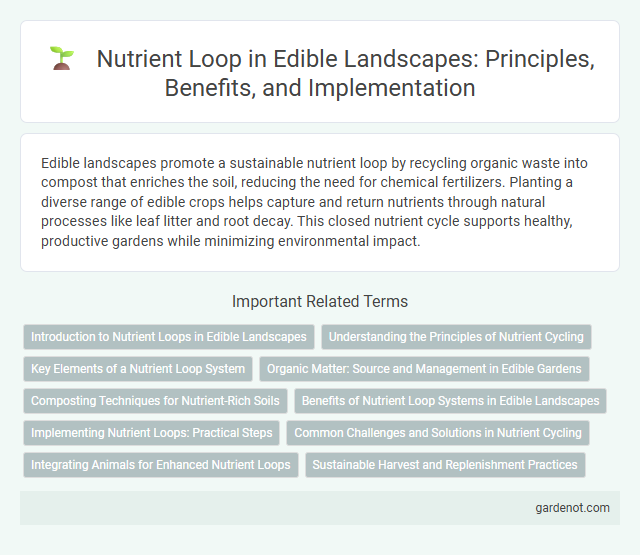Edible landscapes promote a sustainable nutrient loop by recycling organic waste into compost that enriches the soil, reducing the need for chemical fertilizers. Planting a diverse range of edible crops helps capture and return nutrients through natural processes like leaf litter and root decay. This closed nutrient cycle supports healthy, productive gardens while minimizing environmental impact.
Introduction to Nutrient Loops in Edible Landscapes
Nutrient loops in edible landscapes refer to natural cycles where organic matter, such as plant residues and food scraps, decomposes and returns essential nutrients to the soil. This process supports soil fertility, enhances plant growth, and reduces the need for synthetic fertilizers by promoting efficient nutrient recycling. Implementing nutrient loops strengthens ecosystem health and sustains productive edible landscapes through continuous nutrient availability.
Understanding the Principles of Nutrient Cycling
Nutrient cycling in an edible landscape revolves around decomposing organic matter, which replenishes soil fertility by returning essential nutrients like nitrogen, phosphorus, and potassium to the earth. Microorganisms, fungi, and earthworms play a crucial role in breaking down plant residues and food scraps, facilitating nutrient availability for crops and edible plants. Efficient nutrient loops reduce dependency on synthetic fertilizers, promoting sustainable growth and enhancing soil health for bountiful harvests.
Key Elements of a Nutrient Loop System
A nutrient loop system in an edible landscape revolves around cycling organic matter to maintain soil fertility, emphasizing key elements such as composting, mulching, and nitrogen-fixing plants. Composting transforms kitchen scraps and garden waste into nutrient-rich humus, enhancing soil structure and microbial activity. Nitrogen-fixing plants like clover or beans replenish essential nitrogen levels, while mulching conserves moisture and gradually returns nutrients to the soil, sustaining a continuous nutrient cycle.
Organic Matter: Source and Management in Edible Gardens
Organic matter in edible gardens originates from plant residues, compost, and mulch, serving as a vital source of nutrients that support soil fertility and enhance microbial activity. Effective management involves regular incorporation of kitchen scraps, green manure, and decomposed organic material to maintain a continuous nutrient loop. This process improves soil structure, increases water retention, and ensures sustainable nutrient cycling essential for healthy edible landscapes.
Composting Techniques for Nutrient-Rich Soils
Composting techniques such as aerobic composting, vermicomposting, and bokashi fermentation enhance nutrient loops by breaking down organic waste into nutrient-rich humus, crucial for fertile edible landscapes. Proper management of moisture, aeration, and carbon-to-nitrogen ratios accelerates decomposition and maximizes nutrient retention in soils. Integrating compost into planting beds improves soil structure, boosts microbial diversity, and supports sustainable nutrient cycling essential for healthy crop production.
Benefits of Nutrient Loop Systems in Edible Landscapes
Nutrient loop systems in edible landscapes enhance soil fertility by recycling organic matter and reducing the need for synthetic fertilizers. These systems promote sustainable plant growth through natural decomposition and nutrient release, supporting diverse plant health and increased yields. Efficient nutrient cycling also minimizes environmental impact by preventing nutrient runoff and conserving resources.
Implementing Nutrient Loops: Practical Steps
Implementing nutrient loops in edible landscapes involves composting organic waste to recycle nutrients back into the soil, enhancing soil fertility and plant growth. Utilizing mulch and cover crops helps retain moisture and prevent nutrient leaching while promoting soil microbial activity. Integrating nitrogen-fixing plants such as legumes replenishes nitrogen levels naturally, reducing the need for synthetic fertilizers.
Common Challenges and Solutions in Nutrient Cycling
Nutrient cycling in edible landscapes often faces challenges such as nutrient depletion, soil erosion, and imbalanced microbial activity, which hinder sustainable plant growth. Implementing practices like composting organic waste, integrating nitrogen-fixing plants, and applying biochar enhances soil fertility and promotes efficient nutrient loops. Regular soil testing and tailored amendments address specific nutrient deficiencies, ensuring robust nutrient availability for diverse edible crops.
Integrating Animals for Enhanced Nutrient Loops
Integrating animals into edible landscapes enhances nutrient loops by facilitating natural fertilization and soil regeneration through their manure, which boosts microbial activity and nutrient availability. Grazing animals such as chickens, goats, or bees contribute to pest control and pollination, promoting plant health and productivity. This symbiotic relationship reduces the need for synthetic fertilizers and accelerates nutrient cycling, improving overall ecosystem resilience and sustainability.
Sustainable Harvest and Replenishment Practices
Sustainable harvest and replenishment practices in edible landscapes maintain a balanced nutrient loop by ensuring that organic matter removed through harvesting is compensated with natural inputs like compost, mulch, and nitrogen-fixing plants. These practices enhance soil fertility, support microbial activity, and reduce reliance on synthetic fertilizers, promoting long-term ecosystem health. Careful crop rotation and seasonal planting cycles further optimize nutrient retention and minimize soil depletion.
Nutrient loop Infographic

 gardenot.com
gardenot.com